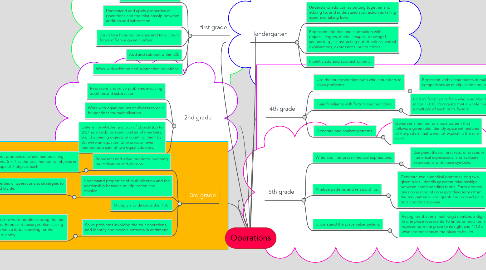
1. first grade
1.1. Represent and solve problems involving addition and subtraction.
1.2. Understand and apply properties of operations and the relationship between addition and subtraction.
1.3. count to a hundred by ones and tens, count forward from a given number.
1.4. Add and subtract within 20.
1.5. Work with addition and subtraction equations.
2. 2nd grade
2.1. Represent and solve problems involving addition and subtraction.
2.2. Work with equal groups of objects to gain foundations for multiplication.
2.3. Determine whether a group of objects (up to 20) has an odd or even number of members, e.g., by pairing objects or counting them by 2s; write an equation to express an even number as a sum of two equal addends.
3. 3rd grade
3.1. Represent and solve problems involving multiplication and division.
3.1.1. nterpret products of whole numbers, e.g., interpret 5 × 7 as the total number of objects in 5 groups of 7 objects each.
3.2. Understand properties of multiplication and the relationship between multiplication and division.
3.2.1. Apply properties of operations as strategies to multiply and divide.
3.3. Multiply and divide within 100.
3.4. Solve problems involving the four operations, and identify and explain patterns in arithmetic.
3.4.1. Solve two-step word problems using the four operations. Represent these problems using equations with a letter standing for the unknown quantity
4. kindergarten
4.1. Understand addition as putting together and adding to, and understand subtraction as taking apart and taking from.
4.2. Represent addition and subtraction with objects, fingers, mental images, drawings1, sounds (e.g., claps), acting out situations, verbal explanations, expressions, or equations.
4.3. Fluently add and subtract within 5.
5. 4th grade
5.1. Use the four operations with whole numbers to solve problems.
5.1.1. Represent verbal statements of multiplicative comparisons as multiplication equations.
5.2. Gain familiarity with factors and multiples.
5.2.1. Find all factor pairs for a whole number in the range 1-100. Recognize that a whole number is a multiple of each of its factors
5.3. Generate and analyze patterns.
5.3.1. Generate a number or shape pattern that follows a given rule. Identify apparent features of the pattern that were not explicit in the rule itself.
6. 5th grade
6.1. Write and interpret numerical expressions.
6.1.1. Use parentheses, brackets, or braces in numerical expressions, and evaluate expressions with these symbols.
6.2. Analyze patterns and relationships.
6.2.1. Generate two numerical patterns using two given rules. Identify apparent relationships between corresponding terms. Form ordered pairs consisting of corresponding terms from the two patterns, and graph the ordered pairs on a coordinate plane.
6.3. Understand the place value system.
6.3.1. Recognize that in a multi-digit number, a digit in one place represents 10 times as much as it represents in the place to its right and 1/10 of what it represents in the place to its left.

